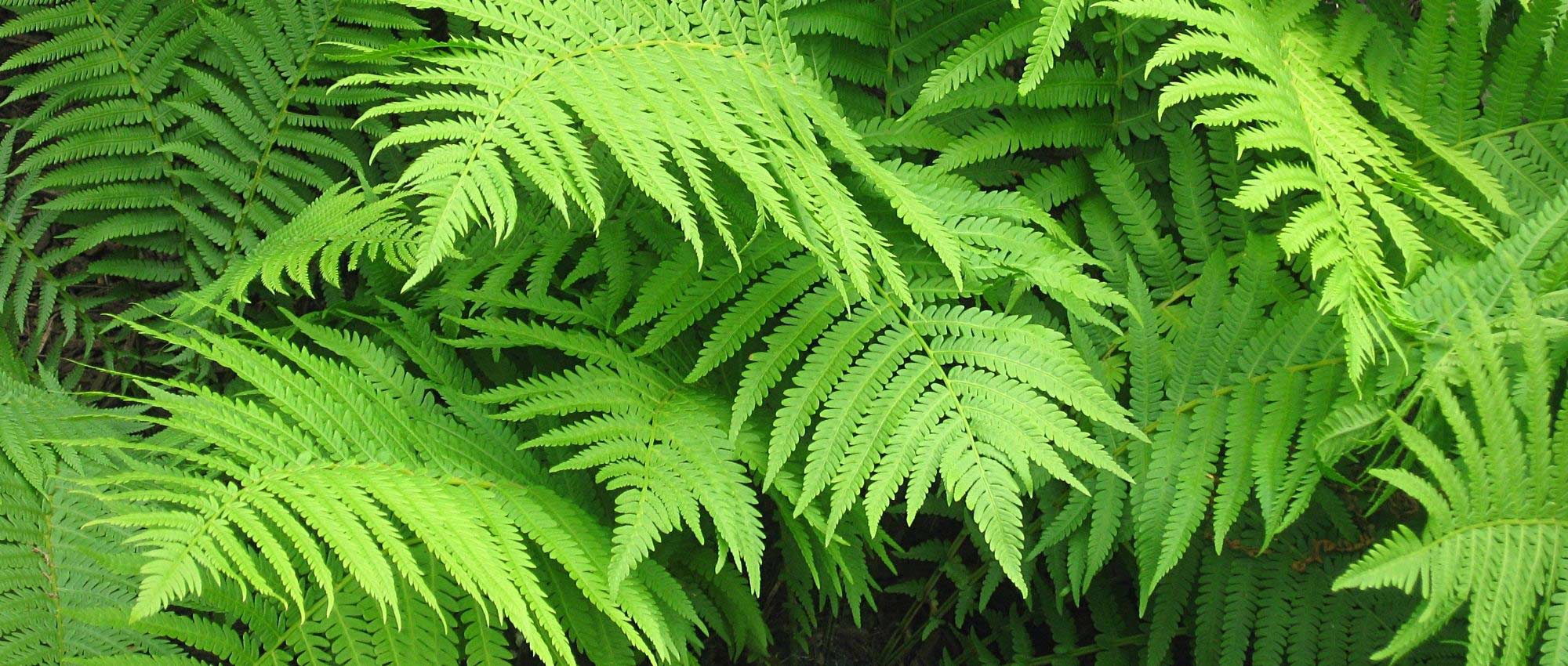
Matteuccia: planting, growing, and care
Contents
Matteuccia in a nutshell
- Matteuccia ferns are very elegant, forming a crown of upright, slightly spreading fronds.
- Their fronds are large and beautifully divided, a soft green colour, resembling ostrich feathers!
- They thrive in shade, in woodlands, in cool to moist soil.
- They are ideal for enhancing the edge of a pond.
- These ferns are quite hardy and require little maintenance.
- They can naturalise and, over time, form beautiful colonies.
A word from our Expert
Matteuccia is undoubtedly one of the most beautiful hardy ferns ! It has an incredible graphic quality, with majestic fronds that unfold from a wide crown. Its large, delicately divided fronds earn it the nickname ostrich fern! We also appreciate their lovely light green colour, a fresh and bright shade. They are beautifully arched. The most commonly grown is Matteuccia struthiopteris, which tends to gradually spread over time thanks to its rootstock, without becoming invasive! Other species are also cultivated, such as Matteuccia orientalis and Matteuccia pensylvanica. Matteuccia are deciduous: their foliage dries up in autumn with the cold, and the plant then enters dormancy, waiting for spring.
Matteuccia are impressive ferns that bring a very natural style to the garden, creating a woodland atmosphere. They need to be planted in shade or partial shade, in rather cool soil. If you meet these conditions, Matteuccia are easy to grow! Like most ferns, they are plants that require almost no maintenance. Moreover, they are quite hardy, able to withstand temperatures down to -20 °C. The most important thing is not to let the soil dry out. Matteuccia is perfect for enhancing the edge of a pond! You can plant it alongside Japanese primroses, Iris sibirica, Euphorbia palustris… and of course with other ferns. Additionally, Matteuccia struthiopteris is a fern that naturalises: it gradually spreads thanks to its rootstock, forming beautiful colonies.
Botany
Botanical data
- Latin name Matteuccia sp.
- Family Onocleaceae
- Common name Ostrich plume fern, German fern
- Flowering none
- Height between 80 cm and 1.70 m
- Exposure shade or partial shade
- Soil type cool, even moist, fertile
- Hardiness -17 to -25 °C
Also known as Ostrich plume fern or German fern, Matteuccia are beautiful ferns native to temperate zones of the Northern Hemisphere. They grow in Asia, Europe, and North America. The Matteuccia orientalis for example comes from Asia, Matteuccia pensylvanica from North America, while Matteuccia struthiopteris has a wider distribution: Europe, North America, Asia… In Europe, it is mainly found in Germany, the Alps, and Scandinavia. In the wild, Matteuccia are primarily found in deciduous forests, in wet meadows, in ditches, or along waterways. Thus, they mainly grow in moist soils. They are hardy plants, as they can withstand temperatures dropping to around -20 °C. In gardens, the most cultivated species is Matteuccia struthiopteris.
Matteuccia are named in honour of Carlo Matteucci (1811-1868), an Italian physicist and politician. The species name M. struthiopteris comes from pteris: wing, and struthion: ostrich, as the shape of the fronds resembles ostrich feathers, hence its nickname of ostrich plume fern.
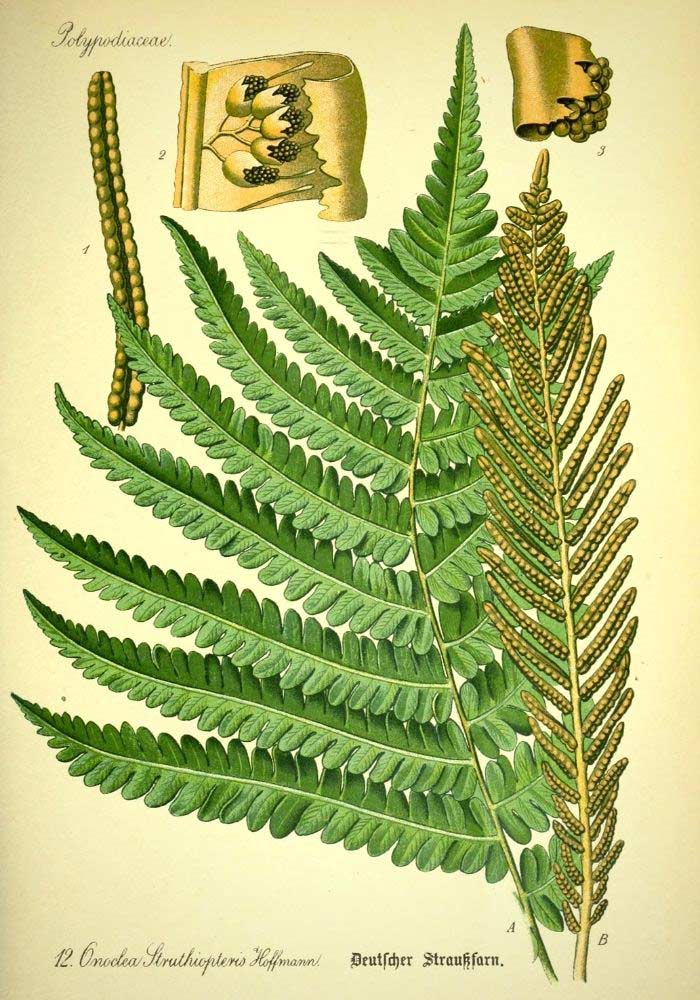
Matteuccia struthiopteris: Botanical illustration
Matteuccia belongs to the small family of the carpet fern Onoclea sensibilis: the Onocleaceae, a family that includes only 9 species. In fact, Matteuccia orientalis is sometimes referred to as Onoclea orientalis.
Matteuccia form a very elegant crown of well-erect fronds when young, and slightly spreading, giving a funnel shape. As they grow, the fronds take on a more spreading and arched, more horizontal shape. They gradually spread out. Matteuccia reach between 80 cm and 1.70 m in height. There is also a giant variety, found under the names ‘Jumbo’ or ‘The King’, which can reach up to 2 metres tall! The rhizome of Matteuccia can also grow vertically, elevating the tuft of leaves, thus forming a pseudo-trunk, 15 to 20 cm high.
Matteuccia struthiopteris spreads through its rhizomes, which form long underground stolons, sometimes measuring several metres long. Over time, it thus forms beautiful colonies. Nevertheless, it is a plant that spreads slowly. It creates a lovely green setting, bringing a very natural and wild style.
In spring, usually around April, Matteuccia forms croziers, which then unfold to form majestic fronds. They are large and arched, and have a shape resembling ostrich feathers. The fronds are beautifully cut, arranged like feathers around a central axis, the rachis. They are twice divided: the fronds divide into pinnae, which are further divided into pinnules. They generally measure 1 m to 1.20 m long and are beautifully arched backward. They tend to spread a bit over the seasons: first well-erect when young, they then gradually droop towards the ground. Their lovely light green colour is appreciated, a fresh and bright shade.
Like all ferns, Matteuccia do not produce flowers or seeds, but reproduce by producing spores. These are reproductive cells, fine as dust, which are emitted on the fronds and detach when mature. They will germinate on the ground, in contact with water, and give rise to prothalli: small organisms resembling moss, which will bear the reproductive organs. Water will allow fertilization, and then a new small fern will gradually develop, in the form we know.

The fronds of Matteuccia struthiopteris (photos: Muriel Bendel, Harum koh, and Kenpei)
In Matteuccia, the spores are borne on fertile fronds that appear in mid to late summer (from July-August) and persist throughout the winter. They appear at the centre of the tuft, among the sterile fronds. They are shorter than the sterile fronds, measuring up to 35 cm long. They also have a stiffer shape, being quite rigid and upright, initially green then brown, and are borne on a long petiole.
Matteuccia is a deciduous fern: its sterile fronds dry out in autumn and unfold again in spring. However, its fertile fronds generally remain in place throughout the winter.

The fertile fronds of Matteuccia struthiopteris, bearing the spores
The croziers of Matteuccia struthiopteris are edible and are consumed in Quebec and Asia. They were also commonly eaten by the Indigenous peoples of Canada. They are nicknamed “fiddleheads”. They are harvested in spring when they are still tender and well curled, and do not exceed 15 cm in height. The curled part of the frond should be cut, and care should be taken not to pick them too developed, already unfurled, otherwise they become toxic. Avoid also harvesting all the croziers from the same plant, but leave at least half in place, to allow them to develop and not compromise the survival of the plant. Once harvested, consume them quickly, cooking them for 10 to 15 minutes in boiling water.
“`
Read also
Ferns: how to choose them?The main varieties of Matteuccia
The most popular varieties
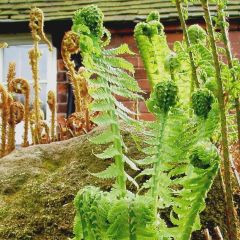
Matteuccia struthiopteris - Ostrich Fern
- Height at maturity 80 cm
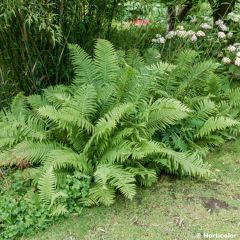
Matteuccia orientalis - Ostrich Fern
- Height at maturity 80 cm

Matteuccia struthiopteris var. pensylvanica - Ostrich Fern
- Height at maturity 1,20 m
Discover other Matteuccia
View all →Available in 1 sizes
Available in 2 sizes
Available in 1 sizes
Planting
Where to plant?
Like most ferns, Matteuccia is a plant that naturally grows in woodlands: it thrives in shade or partial shade. It is ideal for planting under deciduous trees. The exposure also depends on your geographical location: it can tolerate sunlight if you live in northern France, whereas in the south, it is important to place it in the shade! Similarly, it can handle a bit more sun if the soil remains cool at all times. In any case, it is important to plant it in cool, even moist, fertile soil. It easily tolerates heavy, clayey soils. Although it is often recommended to grow it in acidic soil, Matteuccia seems to be indifferent to soil pH, comfortably tolerating calcareous soils.
The vigour and speed of growth of Matteuccia depend on where they are planted: if you place them in rich soil that stays cool at all times, they will grow much faster than in poor soil that tends to dry out at times.
Matteuccia are ideal ferns for enhancing the banks of a pond! This situation will suit them perfectly. You can also plant them in a more ordinary bed, as long as the soil remains cool. However, Matteuccia grows larger when the soil stays moist, while its size is reduced in slightly drier soil.
When to plant?
We recommend planting Matteuccia in spring or autumn. Avoid periods of frost or extreme heat.
How to plant?
- Start by placing the root ball in a basin filled with water to rehydrate it.
- Dig a planting hole two to three times the size of the root ball.
- Mix some well-decomposed compost into the soil to enrich it.
- Then place your fern in the planting hole. The top of the root ball should be level with the soil.
- Replace soil all around, and firm it down with the flat of your hand.
- Water generously.
- We recommend adding a layer of mulch around the fern: this will help limit weed growth and keep the soil cool. You can use, for example, fallen leaves or RCW (ramial chipped wood).
Continue to water regularly after planting until the Matteuccia is well established.
For more tips, feel free to consult our guide on planting ferns.
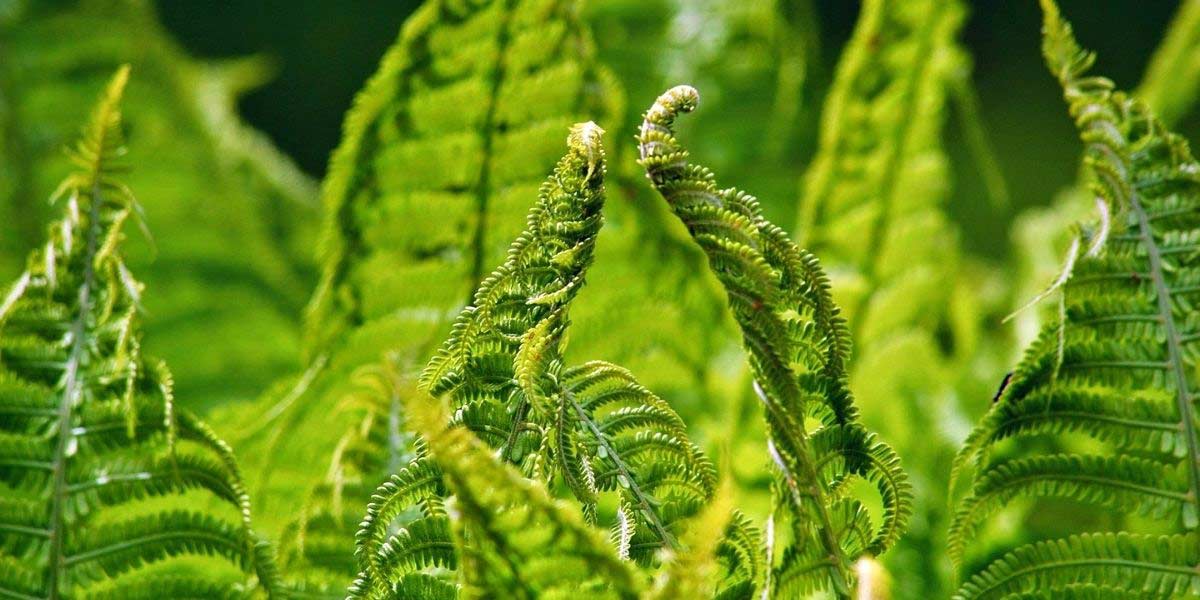
Matteuccia struthiopteris (photo Joanna Boisse)
Read also
How to sow fern spores?Care
Like other ferns, Matteuccia require almost no maintenance: they are robust and hardy plants that are not susceptible to diseases or parasitic infestations. The most important thing is to prevent the soil from drying out by watering when necessary, especially after planting and during dry periods. We also recommend adding a thick layer of mulch around the stump to help retain soil moisture for longer. Don’t hesitate to enrich the soil by adding well-decomposed compost. At the end of winter – beginning of spring, you can tidy up the clumps by cutting back the dried fronds.
Multiplication
You can propagate Matteuccia by sowing spores or by dividing clumps. Sowing is more delicate and takes longer than division, but the latter requires already established Matteuccia that have begun to form several crowns of fronds.
Sowing
- Harvest the spores from the fertile fronds as soon as they are mature (they detach on their own) and sow them immediately.
- Prepare a transparent container with a mixture of sieved potting soil and sand.
- Moisten the substrate.
- Microwave it for 10 minutes to sterilise it. This helps prevent the development of mosses or fungi.
- Wait for it to cool, then sow the spores on the surface evenly. Do not cover them!
- Cover with plastic wrap to maintain a sterile and moisture-saturated environment.
- Place your sowing in a bright location out of direct sunlight, at a temperature of around 15 °C.
- All you have to do now is be patient!
- Repot the young ferns into individual pots as soon as they reach a size that allows for handling.
Generally, Matteuccia spores take about two weeks to form a prothallus, but it then takes four to five months to form a new young fern.
For more tips on sowing spores, check out our sheet: “How to Sow Fern Spores?”
Division of clumps
Matteuccia regularly produces new crowns of fronds alongside the original one, thanks to its running rootstocks. Simply dig up and take a few of these offsets, then replant them in a new location. The best time to do this is in autumn, around October.
Pairing ideas
As they thrive in the shade, Matteuccia are ideal for creating a very natural woodland garden! To accompany them, nothing is better than hostas, brunneras, and rodgersias for their decorative foliage. Bring brightness with the delicate flowering of Dicentra spectabilis, Solomon’s seal, brunneras, sweet woodruff, and wood hyacinths. Also enjoy ligularias, which offer decorative foliage and beautiful yellow summer blooms!
You can also plant them by the edge of a pond, alongside other plants that enjoy cool to moist soils. Feel free to pair them with Japanese primroses, which bear tall, upright floral stems, very vertical, with tiered flowers, often pink or white. Create a beautiful spring scene by combining Iris pseudacorus or Iris sibirica, trollius, Euphorbia palustris… And the splendid flowering of water clover, Menyanthes trifoliata. You can add a very natural touch with the foliage of reeds Phragmites australis or giant reed Arundo donax. Don’t hesitate to plant alongside Matteuccia other bank ferns, such as Thelypteris palustris or Osmunda.
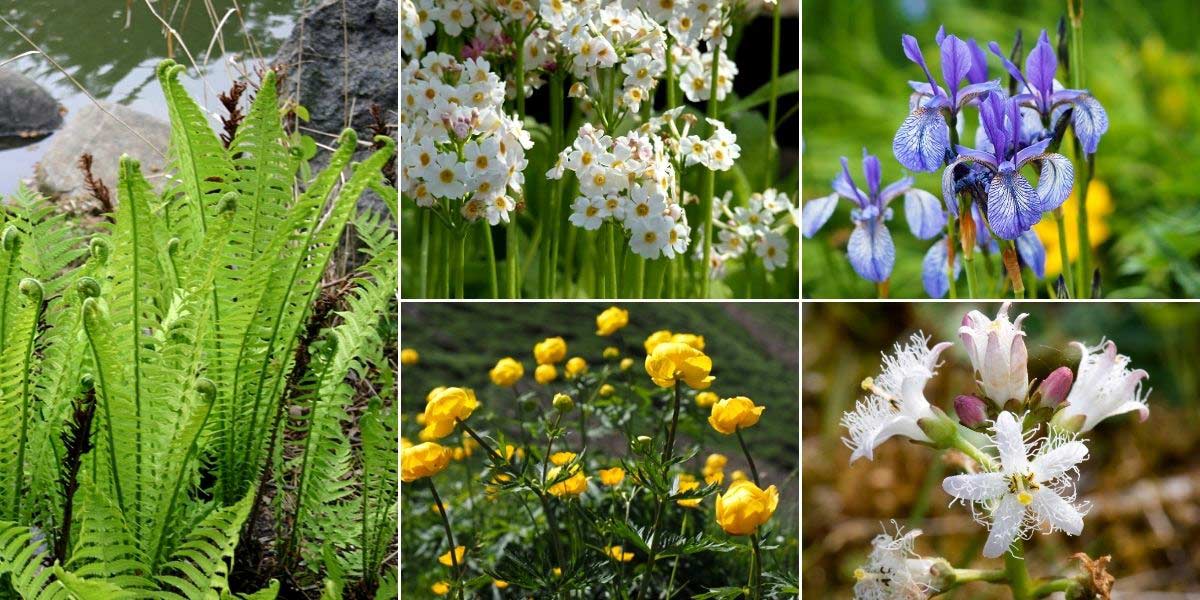
Feel free to plant Matteuccia by the pond, with other plants that enjoy moist soils! Matteuccia struthiopteris (photo Ryan Somma), Primula japonica ‘Alba’, Iris sibirica, Trollius europaeus, and Menyanthes trifoliata (photo Olivier Pichard)
Matteuccia can also fit into a Japanese-style garden. Create a clean decor with well-defined lines, curves, and rocks, on which the small creeping plant Soleirolia soleirolii or helxine can grow. Prefer plants with very structured and graphic forms: Japanese maples, bamboos, hostas, horsetails… This will create a beautiful zen garden atmosphere, conducive to meditation! You can also integrate some grasses, such as Carex morrowii and Hakonechloa macra. Also enjoy the stunning golden foliage of lysimachia nummularia ‘Aurea’, which will follow the shape of the soil or rocks.
The Matteuccia orientalis is perfect for bringing an exotic, lush atmosphere to the garden. You can pair it with Hedychiums, Fatsia japonica, Datisca cannabina, Tetrapanax, bamboos… Also discover the splendid fern Blechnum novae-zelandiae, as well as the impressive flowering of Cardiocrinum giganteum.
If you want more ideas and inspiration for pairing Matteuccia, check out our sheet: “Ferns: 9 easy association ideas to succeed!”
Useful resources
- Discover our range of Matteuccia!
- For more options, or to accompany Matteuccia in the garden, feel free to check our entire range of ferns.
- Fernatic: the French website for fern enthusiasts
- Subscribe!
- Contents


































Comments